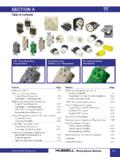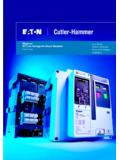Transcription of SOLAR BOOST™ 50 - Blue Sky Energy Inc.
1 SOLAR boost 50. 50A 12/24V MAXIMUM POWER POINT TRACKING. PHOTOVOLTAIC CHARGE CONTROLLER. INSTALLATION AND OPERATION. MANUAL. THIS MANUAL INCLUDES IMPORTANT SAFETY INSTRUCTIONS. SAVE THESE INSTRUCTIONS. COVERED UNDER US PATENTS. 6,111,391 6,204,645. RV Power Products, Inc. 2001 430-0010 F. RV Power Products - SOLAR boost 50. TABLE OF CONTENTS. IMPORTANT SAFETY INSTRUCTIONS .. 2. PRODUCT 3. Part Numbers and Options .. 3. OPERATION .. 3. Current boost .. 4. Optional Digital Display .. 4. Charge Status Indicator .. 5. Three Stage Charge 5. Bulk Charge .. 5. Acceptance 5. Float Charge .. 6. Two Stage Charge 6. 6. Disabling Equalization .. 6. Optional Temperature 7. Maximum Power Point Tracking (MPPT).. 7. How MPPT Works .. 8. Typical Current boost 8. Temperature and Output Power .. 9. 9. Over Voltage / Reverse Polarity 9.
2 Electrostatic Handling Precautions .. 9. Maximum PV Short Circuit Current and NEC .. 9. SOLAR boost 50 Setup .. 9. Default Factory Setup .. 10. Nominal System 11. Charge Mode .. 11. Float Transition Current Measurement 11. Float Transition Current Setpoint .. 12. Maximum Power Voltage .. 12. Optimizing MPPT .. 13. Temperature Compensation .. 13. Acceptance Charge Voltage .. 13. Float Charge Voltage .. 13. SOLAR boost 50 Installation .. 14. Battery and PV 15. Optional Battery Temperature Sensor .. 15. Optional External Current Shunt .. 16. Optional Digital Display .. 16. Input Power Sources Other Than PV Modules .. 16. TROUBLESHOOTING GUIDE .. 17. SPECIFICATIONS .. 19. THREE YEAR LIMITED 19. TABLES AND FIGURES. Table 1 Charge Status Indicator .. 5. Table 2 Typical Current boost 8. Table 3 Maximum Conductor Length for 3% Voltage Drop at 40A.
3 15. Figure 1 Front Panel and Remote Display 4. Figure 2 Lead-acid Charge Voltage Battery Temperature .. 7. Figure 3 Setup and Wiring 10. Figure 4 Detailed Dimensional Drawing .. 14. Figure 5 SB50 Remote Display Cable 16. 1. Installation and Operation Manual IMPORTANT SAFETY INSTRUCTIONS. 1. Refer servicing to qualified service personnel. Incorrect installation may result in risk of electric shock or fire. No user serviceable parts in this unit. 2. Remove all sources of power, photovoltaic and battery before servicing or installing. 3. WARNING - RISK OF EXPLOSIVE GASES. a) Working in the vicinity of lead-acid batteries is dangerous. Batteries produce explosive gasses during normal battery operation. b) To reduce risk of battery explosion, follow these instructions and those published by battery manufacturer and manufacturer of any equipment you intend to use in vicinity of battery.
4 4. PERSONAL PRECAUTIONS. a) Someone should be within range of your voice or close enough to come to your aid when you work near a lead- acid battery. b) Have plenty of fresh water and soap nearby in case battery acid contacts skin, clothing or eyes. c) Wear complete eye protection and clothing protection. Avoid touching eyes while working near battery. d) If battery acid contacts skin or clothing, wash immediately with soap and water. If acid enters eye, immediately flood eye with running cold water for at least 10 minutes and get medical attention immediately. e) NEVER smoke or allow a spark or flame in vicinity of battery. f) Be extra cautious to reduce risk of dropping metal tool onto battery. It might spark or short circuit battery or other electrical part that may cause explosion. g) Remove personal metal items such as rings, bracelets, necklaces, and watches when working with a lead-acid battery.
5 A lead-acid battery can produce a short circuit current high enough to weld a ring or the like to metal, causing a severe burn. 5. PREPARING TO CHARGE. a) Never charge a frozen battery. b) Be sure battery is mounted in a well ventilated compartment. c) Add distilled water in each cell until battery acid reaches level specified by battery manufacturer. This helps purge excessive gas from the cells. Do not overfill. For a battery without cell caps, carefully follow manufacturers charging instructions. 6. CHARGER LOCATION & INSTALLATION. a) Controller employs components that tend to produce arcs or sparks. NEVER install in battery compartment or in the presence of explosive gases. b) Protect all wiring from physical damage, vibration and excessive heat. c) Insure that the controller is properly setup for the battery being charged.
6 D) Do not expose controller to rain or snow. e) Insure all terminating connections are clean and tight to prevent arcing and overheating. f) Charging system must be properly installed as described in these instructions prior to operation. g) Do not connect to a PV array capable of producing greater than 40 amps of short circuit current @ 25 C. SAVE THESE INSTRUCTIONS. 2. RV Power Products - SOLAR boost 50. PRODUCT DESCRIPTION. SOLAR boost 50 is a 50 amp 12/24 volt Maximum Power Point Tracking (MPPT) photovoltaic (PV) charge controller. Through the use of patented MPPT technology, SOLAR boost 50 can increase charge current up to 30% or more. SOLAR boost 50's sophisticated three stage charge control system can be configured to optimize charge parameters to precise battery requirements based on battery electrolyte type, battery size in amp-hours, and battery temperature.
7 The system is fully protected against voltage transients, over temperature, over current, and reverse battery and reverse PV connections. A manual equalize function is also included to periodically condition flooded lead- acid batteries. SOLAR boost 50 employs series pass Pulse Width Modulation (PWM) charge voltage control. The advanced multistage charge control system combined with precise PWM voltage control leads to superior charging and enhanced battery performance. To provide optimum charge control on installations where battery load varies widely during charge, SOLAR boost 50 can interface to an external current shunt to provide optimal charge control. SOLAR boost 50 also includes an automatic current limit feature which allows use of the full 50 amp capability without worrying about overload or nuisance fuse blow from excessive current.
8 The PWM control system uses highly efficient and reliable power MOSFET transistors. The MOSFET's are turned on and off at high frequency to precisely control charge voltage and MPPT. Environmentally sealed high current high reliability relays are used to disconnect the PV array at night to prevent unwanted current drain. Relays are used rather than blocking diodes for improved power conversion efficiency, current boost performance and true reverse battery polarity protection in an MPPT controller. The relays are not stressed by functioning as part of the voltage control system and continually turning on and off as with other PV. controllers. They simply turn on in the morning and off in the evening, and in this application have a life expectancy in 5. excess of 10 operations. Since SOLAR boost 50 is a high efficiency series pass buck type power converter with current limit, the battery can be charged from any power source with a voltage greater than the desired acceptance voltage setpoint, and less than the maximum PV open circuit voltage rating of 57 volts.
9 Examples of this type of use include charge control from hydroelectric or wind generators, or charging a 12 volt battery from a 24 volt system. Fully automatic temperature compensation of charge voltage is available as an option to further improve charge control and battery performance. The available SensorLug battery temperature sensor is built for long term reliability. The sensor element is environmentally sealed and encapsulated into a copper lug which mounts directly to the battery terminal. A user friendly digital display is also available to monitor PV charge performance. The display may be provided in the SOLAR boost 50 controller, as a remote panel, or both. The remote panel cable may be up to 300 in length. PART NUMBERS AND OPTIONS. SOLAR boost 50 controller without digital display SB50D .. SOLAR boost 50 controller with digital display SB50RD25.
10 SB50 remote digital display with 25' cable (standard duplex box mount). SB50D front panel with digital display (add to SB50 to make SB50D). SensorLug battery temperature sensor with 20' cable CS-100 .. 100A/100mV current shunt CS-200 .. 200A/200mV current shunt CS-500 .. 500A/50mV current shunt OPERATION. During installation the SOLAR boost 50 will have been configured to operate in a 12 or 24 volt system, and for three stage or two stage charge. Additional items which may be configured during installation include; acceptance and float voltage setpoints, battery amp-hour capacity, temperature compensation and whether full charge is determined using the internal current shunt or an optional external current shunt. 3. Installation and Operation Manual Once installed and configured, SOLAR boost 50 charge control and MPPT operations are fully automatic .






